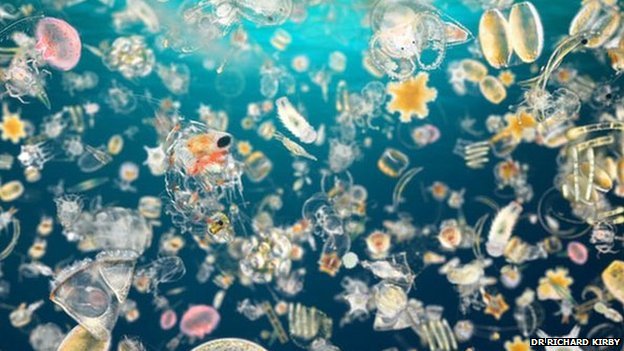Phytoplankton one of the vital life supporting system of organisms, the planet’s most important organism that we as humans have to do whatever it takes to protect and preserve in order for life to flourish persist here on planet earth. Phytoplankton provides 50-60% of earths life supporting OXYGEN, and in return absorb and remove carbon dioxide from the atmosphere, A green house gas that contributes to extreme temperatures and global warming. without Plankton there will be no web of life as we know it on planet earth. The name Plankton comes from Greek words φυτόν, meaning “plant”, and πλαγκτός, meaning wanderer or “drifter”
Phytoplankton are the foundation of the aquatic food web, the primary producers, feeding everything from microscopic, animal-like zooplankton to multi-ton whales. Small fish and invertebrates also graze on the plant-like organisms, and then those smaller animals are eaten by bigger ones like us humans.
Like land plants, phytoplankton have chlorophyll to capture sunlight, and they use photosynthesis to turn it into chemical energy. They consume carbon dioxide, and release oxygen. All phytoplankton photosynthesize, but some get additional energy by consuming other organisms
This has been made a long story short when it comes to understanding Plankton. The reason for this article is to make you understand why we should do whatever it takes to protect and preserve Plankton.
Scientists are discovering that this Microscopic marine algae which forms the basis of the ocean food chain are dying at a terrifying rate, of course the biggest destroyer of Plankton is UVB ultra violet spectrum due to OZONE depletion, Warming oceans and other anthropogenic activities affecting earth at a rate you can’t even comprehend.
Geoengineering is the biggest destroyer of Earths life support system. The spraying of millions tons of Aerosols in the atmosphere decimate the planet in all kinds of ways. The primary ingredient in Stratospheric Aerosol Injection, ALLUMINUM, has been found by scientists that it contaminates and destroys the biosphere in several tremendous ways. The destruction of OZONE LAYER by these Nano particulates create Massive ozone holes in the atmosphere, allowing a band of harmful UV spectrum to reach the earth surface.
The reduction in the amount of algae in the seas could have an impact on a wide range of species, from tiny zooplankton to marine mammals, seabirds, fish and humans.
Most of the declines were seen in polar and tropical regions and in the open ocean, where most phytoplankton are produced.
Phytoplankton, is described as the ‘fuel’ on which marine ecosystems run, are experiencing declines of about 1 per cent of the average total a year.
Global Warming has made oceans 30% more acidic already the
